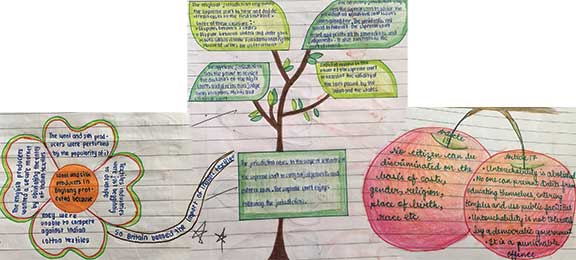Payal Khanna
A classroom is a place of learning and growth integral to a child’s development. A child evolves in these microcosms defined by mutual encouragement and sharing of knowledge. Each classroom structure is unique from the other and thrives in its own distinct culture and dynamics.
The concept of getting children together in a centralized location for imparting learning can be dated back to the 8th century BCE. The education system has evolved multifold since then. Emphasis on the study of varied domains of knowledge has gradually transformed the way learning is imparted. Classrooms have changed from zones of static lectures to places of fluid learning.
However the basic premise of its existence remains the same, acquisition of knowledge. And for any classroom to accomplish that and for the learning to be effective and self-motivated, the undercurrent has to be the same. And that is for the classroom to be a happy space.
Happy classrooms help children take ownership of their learning. A pendulum shift occurs when children feel happy. Happy children are more likely to be naturally engaged than children who are unsure of their presence in the class.
How do we then create such happy classrooms? The usual yet real challenge is the race against time, to finish the extensive syllabus, to justifiably cater to differentiated student subtleties, to struggle to keep up with systemic requirements and other such. And to top it all, who defines the need to craft happy teaching and learning spaces when work can be done with strict discipline? And then there is the everlasting statement that children should be happy all the same, as everything is done for their benefit.
Let’s at this moment take a pause and ask ourselves a question.
Is it the perceived benefit or the best interest of the child that we have in mind while imparting education? Is it about personal satisfaction and instant gratification of having imparted the boxed knowledge or is it about giving the child a choice to take charge of his/her own learning and that too in the most joyous way; though this may require for us to be invested beyond the call of our duty as educators?
For, once we do the latter, the often daunting task of classroom management and adherence to rules dissipates. The student transforms from a reluctant participant to an active learner.
This happens when classrooms are structured as micro spaces full of cheer and learning, where the latter becomes an invariable and natural output.
The answer to almost all the questions lies in returning to the central point, the happiness of each student. As subjective and intangible as it may sound, that is where all the efforts must be directed and that is what the final goal of a good educator must be.

Let’s look at a way in which we can create happy classrooms and happy children.
We can create them with the power of choice. It is by affording choices that we help our students feel empowered and thus joyous. We are well aware of the advantages of involving students in decision-making processes when it comes to setting discipline norms and rewards/sanctions programs in the classroom. But, what about the often overlooked note-taking practices, homework presentations within the expected guidelines and the choice to experiment with the classroom blackboard that is traditionally viewed as the ‘teacher’s dominion’?
During my work with middle/high school students, I have understood that when children are allowed to make informed choices, they become responsible and the quality of work produced increases exponentially.
Let’s look at some of the regular classroom practices one at a time:
Note taking – Attune the students to the idea of organized and structured note-taking practices by getting them to use tools like graphic organizers. The teacher can follow a step by step approach and first introduce the concept of graphic organizers to the students, who can begin by transferring notes from their classwork onto these organizers. Such tools can gradually be used for group presentations. Thereafter students can emulate these structured notes at home. Once they are familiar with them, the students can transition to making their own notes. This way we can equip our students with note-taking strategies, thus giving them a choice to design and customize their own notes.
Home work – Pre-decided formats, pre-set notions, non-inventive answers kill the student’s ingenuity and leech their minds off fertile thoughts. Imagine the freedom to dish out original and artistic yet academically correct notebook work. The interest in maintaining the work will grow exponentially as the dull notebook will metamorphose from a regimented means of learning to a world of creative freedom.
Class black/green board – The world of a child comes alive when he/she walks up to the black/green board, a place of awe and wonder, otherwise an overwhelming sight, for it’s ONLY a device of drudgery and dreary note-copying.
Imagine if this were to serve more as a medium of learning, than a medium of instruction!
So let the children use it as well for group/individual presentations, or to write bullet points of an ongoing lecture in creative and interesting ways. This exercise calls for a great skill of chunking and skimming which will, over a period of time, get honed. This enabling of the student who is allowed to venture into the teacher space effectively and take charge of the classroom learning will translate into ennobling the child.
Finally, it will all filter down to empowering the child and an empowered child will be a happy child.
The author is working as adjunct faculty, History, at Christ University, Bengaluru. She can be reached at payaljindal78@rediffmail.com.
